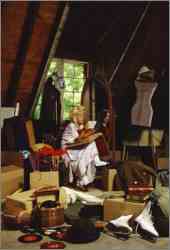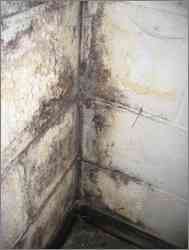|
Is Your Crawlspace or Attic
Making You Sick?
by www.SixWise.com
Crawlspaces and attics are dark, dingy and sometimes damp:
all ideal conditions for mold, fungus, and other germs to
flourish.
|

If your attic is not ventilated properly, mold spores
could be congregating.
|
Mold in crawlspaces is extremely common, and may impact one
in three crawlspaces in the United States, according to mold
remediation specialist Jim Dobbins. It's usually the result
of increased humidity and moisture in the crawlspace, typically
from the ground in the crawlspace, a leak, or inadequate ventilation.
In attics, meanwhile, mold often forms as the result of inadequate
ventilation. Warm moist air, created from the people living
below, rises toward the ceiling and enters the attic around
light fixtures and other openings. If the attic is well-ventilated,
the moisture will pass outside, but if the warm air has nowhere
to go, the moisture will accumulate.
Both attics and crawlspaces are also rich in the organic
materials that molds, fungi and other microbes need to feed
on.
According to the Centers for Disease Control and Prevention
(CDC), "Mold grows well on paper products, cardboard,
ceiling tiles, and wood products. Mold can also grow in dust,
paints, wallpaper, insulation, drywall, carpet, fabric, and
upholstery."
In short, it can grow almost anywhere, as long as moisture
is present.
In fact, according to the U.S. Environmental Protection Agency
(EPA), 30 percent to 50 percent of all structures have damp
conditions that could encourage the growth and spread of biological
pollutants like mold. And that's just for average climates;
in warm, moist climates, this percentage is likely much higher.
What's Dangerous About Mold?
Mold is a microscopic, living organism whose purpose is to
break down dead materials. This is why, over time, it will
destroy whatever it is growing on, including your carpets,
furniture and cabinets, and even structural elements of your
home.
|

If left untreated, mold will gradually destroy whatever
it is growing on -- including structural elements of
your home.
|
However, this is only a part of what makes mold dangerous.
Molds release thousands of microscopic spores into the air,
and they are easily carried around your home, where you may
breathe them in.
It is through this inhalation that mold can cause health
problems to you and your family.
What Types of Health Problems do Molds Cause?
"All molds have the potential to cause health effects,"
says the EPA. "Molds can produce allergens that can trigger
allergic reactions or even asthma attacks in people allergic
to mold. Others are known to produce potent toxins and/or
irritants."
In fact, people who live in homes with mold often report:
-
Respiratory problems, such as wheezing, difficulty breathing,
and shortness of breath
-
Sneezing and/or nasal congestion
-
Eye irritation (itching, burning, watery, or reddened
eyes)
-
Coughing or throat irritation
-
Skin rashes or irritation
-
Headaches
-
Fatigue
Among people who have existing respiratory conditions (such
as allergies or asthma)
or weakened immune systems, as well as children and the elderly,
molds can be particularly dangerous. People in this group
may experience more severe reactions or even serious lung
infections when exposed to mold.
Preventing a Mold Problem in Your Crawlspace or Attic
If you suspect mold is in your home (some indications include
stained ceilings, a musty or earthy smell, black, pink, orange
or green spots on walls, flood
or hurricane damage, damp basement, crawlspace or attic)
you should seek out a professional (a certified mold remediator
or a certified mold contractor) to evaluate your home and
perform the removal.
For those of you who don't, count yourself lucky, and begin
to take the following 11 steps to keep mold from becoming
a problem in your home.
- Use an Air Treatment System to clean your air. We highly
recommend the PIONAIR
Air Treatment System for this purpose. Unlike most air
purifiers, the PIONAIR™ Air Treatment System doesn't
wait for pollutants to contact a filter or plate. Instead,
the PIONAIR generates air-purifying technology that migrates
through the area and neutralizes organic odors, microbes,
and molds at their source.
As a result, the PIONAIR produces fresh clean air throughout
your home or office uniformly, by addressing the pollutant
source -- without the use of fans, filters, or plates.
|
Watch a live animated demonstration of how the PIONAIR
Air Treatment System works, and why its "photocatalysis"
technology makes it superior to other air purifiers.
|
-
Fix any leaky plumbing or other leaks immediately.
-
Prevent moisture due to condensation. To reduce moisture
levels in your air, increase ventilation (if the outdoor
air is cool and dry) or use a dehumidifier (if the outdoor
air is warm and humid).
-
Don't let your home's foundation stay wet. Make sure
there's proper drainage and that the ground slopes away
from the foundation.
-
Keep furniture and floors dusted. Mold spores can collect
in your household
dust, so dusting often is highly recommended. To make
sure that the dust is truly picked up, and not just pushed
around, use the PerfectClean
line of dusters and terry cloths, whose positively-charged
ultramicrofibers pick up everything in their path -- including
dust and all of its microscopic attachments.
-
Keep heating, ventilation, and air conditioning drip
pans clean and flowing properly.
-
Make sure moisture-generating appliances, like your
dryer, and your bathroom and kitchen exhaust fans are
vented outside.
-
Keep indoor humidity levels below 60%, and preferably
between 30-50%.
-
Change your home's air filters regularly.
-
If necessary, add insulation to reduce the potential
for condensation on cold surfaces, such as windows, piping,
exterior walls, roof or flooring.
-
Make sure any damp or wet spots are cleaned and dried
within 48 hours.
Recommended Reading
The
Six Silent Killers in Your Home: How to Detect and Eliminate
Them
You
are Burying Your Face in a Hot Zone for Fungal Spores Every
Night: Your Pillow
Sources
U.S.
EPA: Mold Remediation in Schools and Commercial Buildings
CDC:
Environmental Hazards & Health Effects, Mold
Texas
Department of State Health Services
Traskresearch.com
|